Feast Day: December 27th
In his book, The Da Vinci Code, Dan Brown said that St. John the Baptist, who is sitting to the right of Jesus in Leonardo da Vinci’s Last Supper, actually is St. Mary Magdalene. This is totally moronic. If Brown had spent a nanosecond looking at images of St. John the Evangelist over the course of, say, a few hundred years, he would have known that St. John the Evangelist ALWAYS is on the right side of Jesus at the Last Supper and the dude ALWAYS looks like a lady. St. John the Evangelist is muy importante! You will see him in nearly every scene of the Last Supper and the Crucifixion (just you wait – there are lots of pics to see).
Word is that St. John the Evangelist was the favorite disciple of Jesus. He was a fisherman from Galilee, the son of Zebedee, the brother of St. James the Apostle, and the author of the fourth gospel, which includes the narrative of the Apocalypse. According to his legend, when the Roman emperor Domitian was persecuting Christians, St. John the Evangelist was thrown into a vat of boiling oil, which must have hurt like nobody’s business! Not being a mere mortal, Mr. Evangelist emerged not only unharmed, but also somehow rejuvenated. Wow. Since he couldn’t kill the poor guy, Domitian exiled St. John the Evangelist to Patmos, an island in the Aegean Sea, which actually sounds more like a vacation than anything else. It is there that St. John the Evangelist tripped out, had a vision of the Apocalypse and wrote it all down and THAT, my friends, is how the book of Revelations came to be. He eventually meandered to Ephesus did a bunch a cool things including imbibing the poisoned contents of a chalice and surviving (natch). This is why one of his attributes is the chalice with a snake/devil in it. (He blessed the chalice, the snake/devil slithered out, he drank, and he lived.) His other attribute is the eagle, which is associated with the sky and therefore the high level and union with God to which all Christians should aspire.
When he finally was ready to call it quits, he simply dug himself a grave and crawled right in.
St. John the Evangelist in Art
Here is the extremely famous and decrepit painting of the Last Supper by Leonardo da Vinci. Pretty St. John the Evangelist is to the right of Jesus (which is your left). Remember this: the right of Jesus is the GOOD side and the left often is BAD.
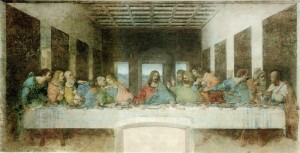
Leonardo da Vinci, The Last Supper, 1495-1498, tempera on gesso, pitch and mastic, 15’ 1”, x 29’, Santa Maria delle Grazie, Milan, Public Domain via Wikimedia Commons.
Here’s some dashi with John. He looks super old because all of this happened at the end of his life and he was VERY long in the tooth when he died. Rumor has it he lived until the reign of Trajan, which was 93-117 CE.
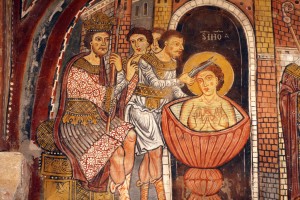
Anonymous Artist, St. John the Evangelist in Boiling Oil, 1237, Crypt of St. Magnus, Cathedral of Santa Maria, Anagni, Lazio, Photo by Holly Hays via Flickr, Creative Commons Attribution-Non Commercial 2.0 Generic License.
Here we go again. Notice the eagle on the flag behind him and they are both looking UP toward heaven for help. Get it? I don’t know why that horse is smiling. Nice codpiece.
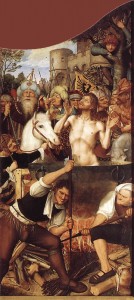
Quentin Massys, The Martyrdom of Saint John the Evangelist, right wing of the St. John of the Evangelist, 1507-8, oil on wood, Koninklijk Museum voor Schone Kunsten, Antwerp, Public Domain via Wikimedia Commons.
I told you they were close. Aww!
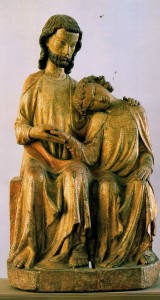
Anonymous Artist, Christ and St. John the Evangelist, c. 1330, Staatliche Museen zu Berlin–Preussischer Kulturbesitz, Public Domain via Wikimedia Commons.
St. John the Evangelist is one of the snoozers in the Garden of Gethsemane where Jesus asked them NOT to fall asleep while he prayed to see if he could avoid the whole sacrifice thing. Saints Peter, James and John the Evangelist got a big, “Thanks a lot!” from Jesus when they woke up.
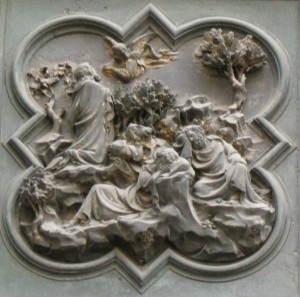
Lorenzo Ghiberti, Agony in the Garden, North door of the Florence Baptistery, 1404-1424, Florence, Photo by sailko via Wikimedia Commons, GNU Free Documentation License.
Here it is again. St. John the Evangelist is the pretty one – remember? Zzzzzz.
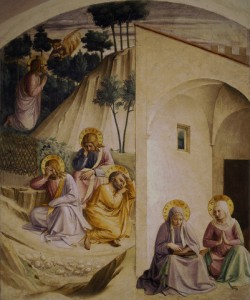
Fra Angelico and his workshop, Agony in the Garden, c. 1443-1445, Convento di San Marco, Florence, Public Domain via Wikimedia Commons.
St. John the Evangelist had to deal with the Virgin Mary when Jesus died. He is almost always in scenes of the Crucifixion because the Bible says he was there. Here’s a real old timer.
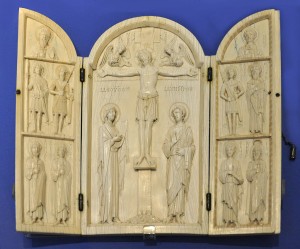
Anonymous Artist, The Borradaile Triptych, 10th century, ivory, British Museum, London, Photo by Andrea Praefcke via Wikimedia Commons, Artwork in the Public Domain.
Here is a pile of Holy people. Can you spot St. John the Evangelist?
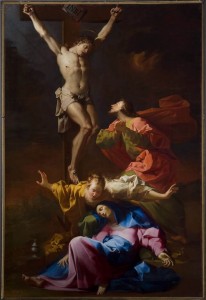
Francesco Conti, Crucifixion, c. 1709, oil on canvas, 125” x 85”, Galleria degli Uffizi, Florence, Public Domain via Wikimedia Commons.
St. John the Evangelist had a big job in dealing with the Virgin at the time of the Crucifixion. This artist made that point very clear when he gave St. John the Evangelist a huge, claw-like hand and long arm so that he could “support” the mother of Jesus at that moment.
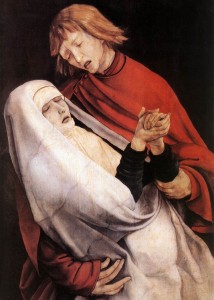
Matthais Grünewald, Detail from the Crucifixion, Isenheim Altarpiece, c. 1515, oil on panel, Unterlinden Museum, Colmar, Public Domain via Wikimedia Commons.
St. John the Evangelist was there with St. James and St. Peter at the Transfiguration, which is when Jesus did sort of a magic trick. He took these guys up Mt. Tabor in Galilee and made his face shine like the sun and his clothes turn white. Man, those guys bugged out!
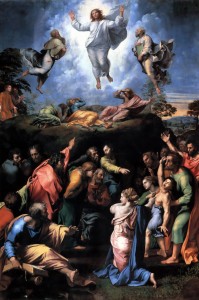
Raphael, Transfiguration, c. 1518-1520, Pinacoteca vaticana, Rome, Public Domain via Wikimedia Commons.
St. John the Evangelist also was there for the Descent of the Holy Spirit, the Death of the Virgin, and the Assumption of the Virgin, … but I’m getting kind of tired of all of this. Let’s get back to his story. The only other subject from the life of St. John the Evangelist that appears often in art is his exile on Patmos and his vision of the Apocalypse.
Here’s one by everyone’s favorite artist, Hieronymus Bosch. Note the angel has begun to narrate the events to the saint, who is scratching it all down as quickly has he is able. The show is beginning as the Virgin of the Apocalypse, sitting on a crescent moon and wearing a crown, appears in the sky. Look at the cool creature on the lower right.
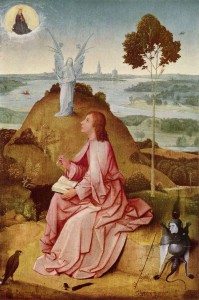
Hieronymus Bosch, St. John the Evangelist on Patmos, c. 1489, oil on panel, 24.8” x 17”, Staatliche Museen, Berlin, Public Domain via Wikimedia Commons.
OK, here’s something fun to do. Believe it or not, you can see all of the events from the Book of Revelations in the corner of this painting. Go ahead and read along by clicking here!
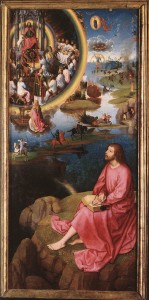
Hans Memling, St. John the Evangelist on Patmos, from the St. John Altarpiece, 1474-1479, oil on panel, 69.3” x 31.1”, Memlingmuseum, Bruges, Public Domain via Wikimedia Commons.
To buy some stuff with St. John the Evangelist, click here.